Water play is one of those activities that stands the test of time. You can entertain a baby all the way through adulthood by simply adding water.
Water play is also a great sensory activity for young learners. Check out my post “What’s the Deal with Sensory Play” if you want to know why sensory play is so important.
It’s getting really hot here in Las Vegas, so water play is a must if we want to play outside at all. And, honestly, sometimes it’s just too hot so we bring water play inside. You can also do this if it is cold where you live. Water play is great year round.
Water play encourages learning through play. Children are learning:
- Practical life skills (pouring, scooping, transferring)
- Fine motor (squeezing, spraying, picking up)
- Gross motor (carrying buckets of water or transferring heavy water-soaked items)
- Language
- Experimentation and critical thinking skills
- Problem-solving
- Persistence and resilience
Preparation is crucial for a successful water play experience (and any messy activity really). Make sure you:
- Have towels ready (either to dry up after or to lay on the ground for spillage, or both)
- Prepare a change of clothes
- Make sure your spill zone is covered or you are outside
- Remind children that surfaces are slippery when wet
- If your water play includes other messy materials, plan for clean up (with a bath or wet cloth ready)
After you are prepared, both mentally and physically, it is time to get your ideas. If you are like me then you like to have all your ideas in one spot for quick reference. Also, sometimes you feel really motivated and can handle a more complicated set up and other times you just want to throw some cups in the water and call it a day. Both are great and I have included lots of ideas for those times you need a little inspiration.
Disclosure: This post may contain affiliate links, which means we may receive a commission if you click a link and purchase something that we have recommended. As an Amazon Associate, I earn from qualifying purchases at no cost to you. Please check out our disclosure policy for more details.
Water Play Ideas
Sea animals and fish tank supplies
A really fun way to create a water play set up is to use sea animal figurines and fish tank supplies. You can create your own underwater world (without the real fish). Small world play encourages imagination, creative thinking, and language skills.
Making Potions
There are so many variations on this idea. The basic concept is mixing different types of ingredients using scoop, pour, or science tools. Some ideas are adding nature items, colored water, essential oils, herbs and spices, loose parts, pipettes, bowls, measuring spoons, test tubes, and beakers. When we did this we used colored water, oregano, cinnamon, vanilla, measuring spoons, recycled egg container, other recycled containers, and bowls. My one year old stayed focused for around 15 minutes and smelled so much like cinnamon it made me crave a cinnamon roll.
Rescue animals from ice
Put animals in ice trays or other containers and fill them with water. Freeze overnight and then add some tools to “rescue” the animals from the ice. Arctic animals are great for this to create a small world scene and discuss which animals live in cold places, as well as their adaptations to live in a cold place.
Ask questions like “How does a seal stay warm?” “Why doesn’t a lizard live in a really cold place?”
If you are looking for some ice play ideas during the winter, take a look at my post “Easy Christmas Activities to Keep your Toddler Busy.”
Ball Pit Balls
This is a simple one for those days you don’t really have the motivation. Throw a bunch of balls (doesn’t even have to be ball pit balls) into a kiddie pool or water table and let them play. I added one bowl just to have somewhere to put the balls and my little one loved it. This was way more of a hit than I anticipated.
Balls are one of our favorite loose parts for babies and toddlers. So, I should not be surprised that this was so engaging for R. Find out more about loose parts for infants and toddlers HERE.
Ice Cubes
Lots of variation for ice cube play. You could have them colored, freeze larger portions of water, do experiments, add sticks or other holders, create an arctic scene, etc.
Warm and Cold
Another use of ice cubes is using them to explore warm and cold. You can also explore warm and cold with hot/cold packs, warm/cold water in Ziploc bags, and warm/cold wet cloths.
Water and ramps or pipes
You can use a variety of materials to create pipes and ramps.
Some possible materials include:
- pool noodles
- PVC pipes
- rain gutters
- recycled bottles
- Plastic cups
- hoses
- pipes
- Legos
Mirrors
This was another idea that was way more engaging than I anticipated. We did this when Ruby was about 10 or 11 months and she loved to look at herself in the mirror (what baby or toddler doesn’t, right?).
We used real mirrors under careful supervision, but if you are concerned you can also purchase acrylic mirrors that won’t break. This would be fun for older children to explore reflection and refraction.
Bike Wash
I have seen people get really creative here and create a whole bike was with PVC piping, but you don’t have to do that. You can just get out the water hose, a bucket of soapy water and some large sponges and your little one will have so much fun. Plus, their toys will get cleaned.
Pom Poms
Pom poms are another one of our favorite loose part to use in play (Grab your FREE list of over 100 loose part ideas HERE). You can add them to water to scoop and pour, to squeeze, to post into a container, or use them frozen for a whole new experience.
We did Frozen pom poms and it was so fun for R and I imagine it would be great for any teething baby. Check out my 7 Hacks for Teething Babies and Exhausted Parents if you are in need of some creative teething solutions.
To freeze the pom poms, I soaked them in water then put them in a repurposed egg container in the freezer. They came out like little frozen balls. You can also fill ice cube trays with water and put them in if you want them more like a cube.
Wash Cars, Animals, Dishes, pretend food, or dolls
Kids love to wash toys. You can even get them intentionally dirty by putting them in mud, oobleck, sand, or dirt then have the children wash them from there. Adding sponges, wash cloths, loofahs, repurposed shampoo bottles or soap pump bottles creates more interest as well.
In Autumn we did farm animals in “mud” jelly and Ruby’s favorite part was washing the animals off.
Check out our other sensory ideas for Autumn HERE.
Splash Pad
We received a splash pad for R’s first birthday (See some of her other first birthday gifts) and it was so fun to play with. It really helped cool off on an especially hot day. If you do not own a splash pad you can either visit one at a local park if available or make one by simply poking holes in an empty bottle and taping it to a hose. You can even turn your trampoline into a splash pad, which is a great idea from cheerstolifeblogging.com (you can find more summer fun on their post “19 Exciting Fun Summer Activities at Home for Kids”)
Painting with water
We have done this a couple ways. We have used various painting tools like paintbrushes and paint rollers to paint outside on the ground and we have also used smaller paintbrushes to paint on a calligraphy mat. If you have not seen or used a calligraphy mat, then I highly recommend it! They paint with water, it shows up black, then it evaporates and you can paint again. It is similar to an aqua doodle mat with less decoration and distraction. Plus, no mess!
Make Boats
You can be as creative or simple as you would like with this. Gather any material that might float and let your child build their own or create some simple boats for your child to explore. Some possible materials for creating boats include foil, foam, cut up pool noodles, clay, sticks, sponges, ice, Legos, corks, popsicle sticks, and egg cartons.
Citrus Water Play
My husband has been working from home since March and lately he has been conducting several interviews. One of the questions he asks is, “How would you describe the color yellow to someone who cannot see?”
That question really got me thinking and it inspired this multi-sensory yellow experience. The water was warm also so R was exploring through sight, taste, smell, and touch.
We used our Grabease fork to stab the lemons and that created a whole new dimension to this activity. I plan to add the fork to other sensory experiences so that she may learn practical life skills in a fun way instead of only at meal time.
You can also use other citrus for this activity.
Loose Parts
Many of the ideas listed in this post are already using loose parts, but find any of your favorite loose parts and add them to water, you will have a simple open-ended activity that will most likely keep your children occupied and use their creative thinking skills. (See also “Loose Parts Play for Infants and Toddlers” and “Loose Parts Play Ideas”). The beauty of loose parts is they also stand the test of time, so if you are looking for an idea to entertain multiple ages, then using loose parts or any open-ended material will help you accomplish this. Grab your FREE list of over 100 Loose Parts Ideas HERE.
Colored Water
We have explored several colors with water. Simply find random objects and toys around the house with the same color, put them in a bin with colored water and you have a color exploration. You can simply add colored water with your normal water play tools and it adds new interest to an activity you might already have set up from the day before. You can also use the colored ice to melt together and mix colors in water.
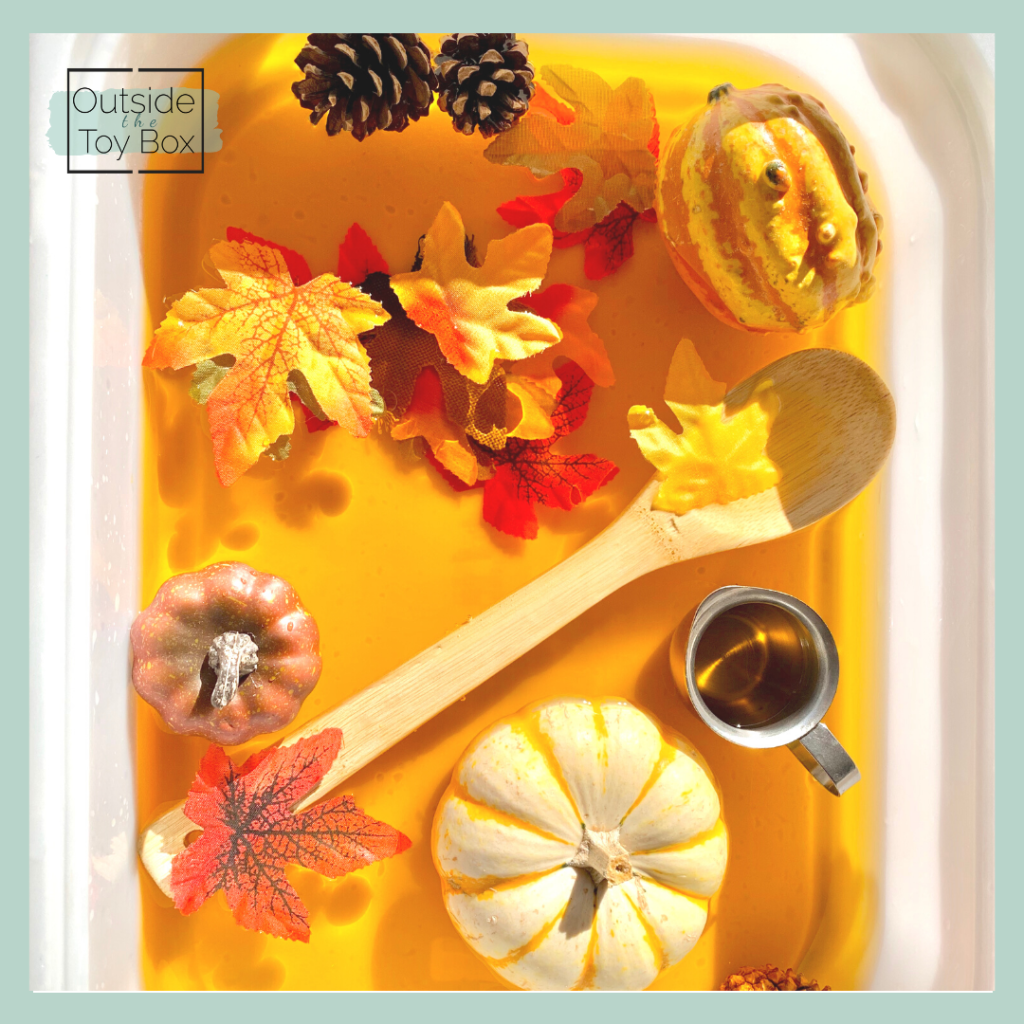
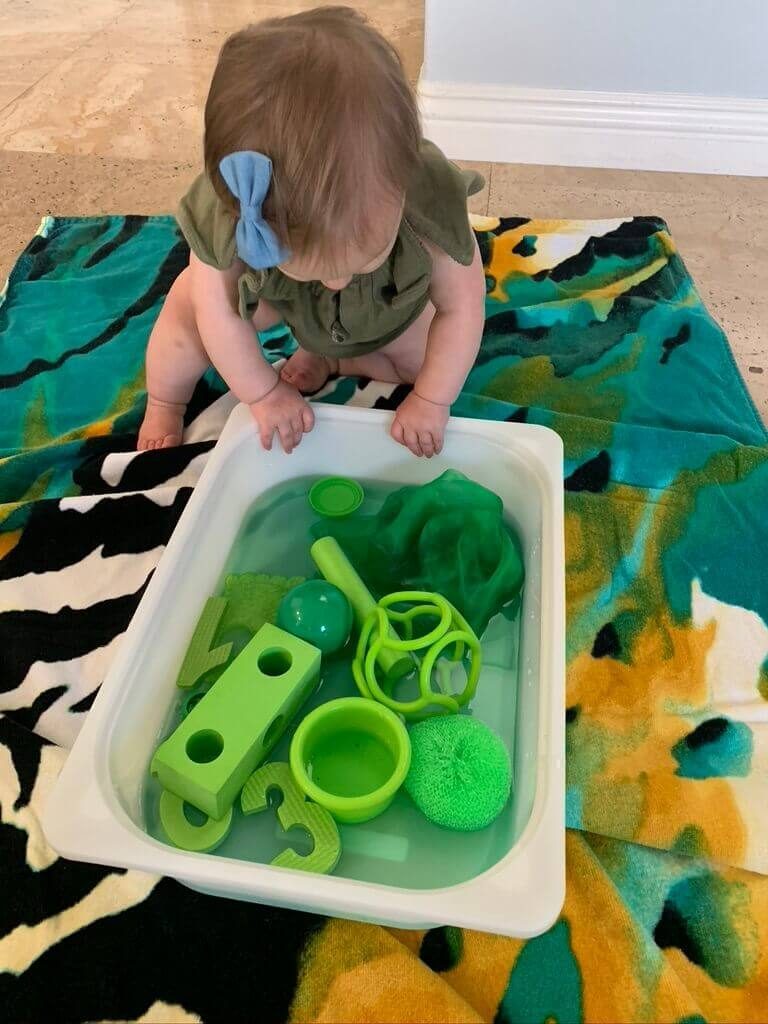
Water Balloons
Fill some water balloons and have a water balloon fight. If you have babies or toddlers and don’t feel comfortable with water balloons, you can fill up regular balloons only part way and they do not break as easily. They wibble and wobble and are great to encourage fine motor and coordination to hold onto them. You could also try a more eco-friendly option like reusable water balloons.
Photos
You can laminate or put photos in Ziploc bags to add them to water. R loved to look at the pictures as she played in her kiddie pool. You could also tape pictures to blocks and then add those to your water play (see also “Playing with a 6 to 12 month old Baby Using Pictures”)
Pool Noodles
Multiple ways to use this very affordable resource. Pool noodles can be left long and add a hose to the end. You can create your own sprinkler by poking holes and taping the end with the hose on the other end. You can also cut them lengthwise and create ramps and pipes. You can also cut them up to create boats.
Shells or Natural Materials
This is another easy, low-motivation day activity. Shells are fun to add with sea creatures, but can also be fun alone in water. If you don’t have shells, find some rocks, sticks, flowers, or leaves and they make a beautiful water play set up. The one pictured here is not the most beautiful, but like I said before it was a low-motivation kind of day. #keepingitreal
Float and Sink
A classic water experiment is to provide items that both float and sink. Provide some items that may challenge the typical thought process. Ask open-ended questions to encourage critical thinking.
Some to get you started are:
“Why do you think that sank?”
“How does that float?”
“What are some similarities to the things that float/sink?”
Sponges
Sponges are a great tool to use with water. They absorb water, which offers the child to transfer water by absorbing and then squeezing water instead of scooping and pouring. Also, The variety of textures, colors, shapes, density offers boundless opportunities for sensory play. (Check out my post “10 Ways to Play with Sponges” for more Sponge Play Ideas)
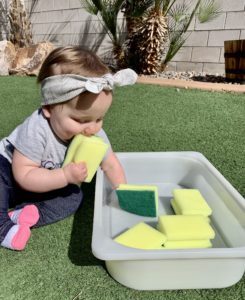
Waterproof books
If your child is like mine, then often they prefer books over toys. Well, now they sell waterproof books for the bath, but you can also use them for water play. If you do not have any you can also make some by laminating some book pages or photos and connecting them together. If you have a real bookworm on your hands, you can also read books about water before or after water play. Simplyworkingmama.com gives a fabulous breakdown of the book Hey, Water by Antoinette Portis in her post “Read and Play Summer Series: Hey, Water.” (BONUS water play ideas at the end of that post).
Kitchen Items
Kitchen items are a go to for water play because they naturally encourage scooping and pouring. In the Montessori world this is considered a practical life activity.
Children love to use “real” tools so you don’t have to go buy the fancy pretend kitchen toys (unless you want to), you can simply use what you have in your own kitchen. Some great tools to use are strainers, spoons, cups, bowls, measuring cups and spoons, funnels, whisks, and turkey basters.
Legos or Duplos
Legos are a great open-ended resource and they are fun to add to water. You can try to create dams, bridges, or boats.
Cups, bowls, Scoops, and other utensils for scooping and pouring
Here is another super simple idea that doesn’t take a lot of thought, planning, setup time, or motivation. Gather some water toys, cups, and scoops and let them free to explore scooping and pouring.
Check out our favorite sensory play tools
Paint water over chalk
If you want to make it educational you can draw shapes, letters, or numbers and have your child trace them with water on paintbrushes. You can also let them draw with chalk and then have them paint over their creations. Another fun idea is to draw a fire with chalk and have them spray it out.
Water beads and water (put them in a bag or bottle for a little one)
Water beads are so fun and such a great sensory experience. You can have them alone with scooping and pouring tools or with toys. You can also add water.
Either way for a baby or toddler that is still putting things in their mouths you can put water beads in a Ziploc bag or in a clear bottle for them to explore. There are also giant water beads that are less of a choking hazard. You can also use tapioca balls for edible water beads. You can find more edible sensory play ideas HERE.
We explored water beads in a bag on the light table and taped on a window. Both offered the opportunity to explore their beautiful colors and translucent property, but also allowed for horizontal and vertical play.
Spray water
Get the spray bottles out and you can either spray clear water just for fun or you can do some water art by adding some color to the water and spray onto paper.
Frozen Peas
An edible idea is to add frozen peas to water. It is also a great fine motor activity for babies or toddlers. You can also add scoops and cups to put the peas into. We added an ice tray when we did this, but Ruby just enjoyed picking out the peas and eating them.
If you are looking for more edible sensory play ideas for your baby or toddler who mouths everything, take a look at my post “Edible Sensory Play.”
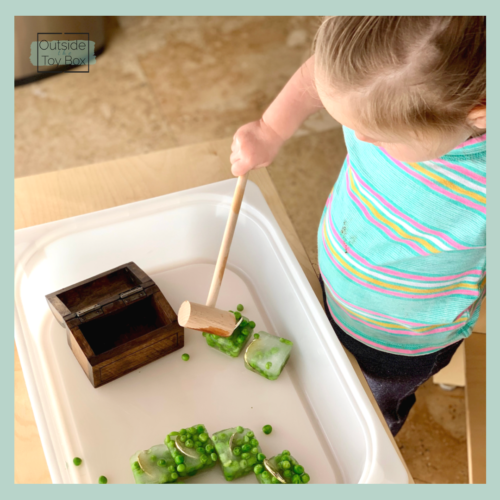
Recycled Bottles
Super simple, low prep, and low motivation. You can collect various recycled bottles and throw them in some water. Some interesting bottles are empty spice containers, parmesan cheese containers, and various sized containers.
Scarves
Something we don’t always consider adding to water is fabric. If you have translucent scarves they are fun to add to water and can be an alternative to dying the water, but you can really add any kind of fabric and it adds a new sensory experience.
Tea Party
Classic get a tea set or some cups, plates, bowls, and spoons from your kitchen and set up a tea party. You can add pretend food or stuffed animals to join in on the fun.
Fishing for Letters
A great way to practice letter recognition and naming is to go fishing for letters in water. See how teachinglittles.com did this in their post “Fishing for Letters Toddler Outdoor Activity.”
Fruit or veggies in water
Dreaming of a spa day? Well, you can take a piece of that as inspiration by creating some cucumber water. You can add other fruits or veggies to water too.
Mix Oil and Water
Classic experiment of mixing oil and water. You can mix them in a bottle to create a fun sensory bottle or you can have colored water with eye droppers and drop the water into oil.
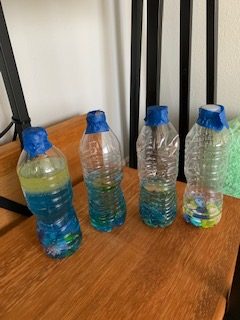
Sponge Bombs
Cut up some sponges and tie them in the middle. Soak them in water and throw them to create a fun sponge bomb. You can also just soak regular sponges and throw them to watch them splash or to get others wet.
Color Mixing
Adding color to water is so much fun. You can encourage color mixing by adding supplies for pouring and some empty containers for mixing the colors.
Strainers and toys
Strainers and toys allow transferring skill practice. This is a great practical life activity and also uses bilateral coordination (using both sides of the body and crossing the midline). Check out teachinglittles.com for details on their “Toy Water Scoop Sensory Bin.”
Painting Ice
Another fun way to play with colored water is to paint ice. Get some colored water and use it either in a spray bottle or with paint brushes to paint the ice.
You could also use other types of paint or freeze paint and paint with the frozen paint.
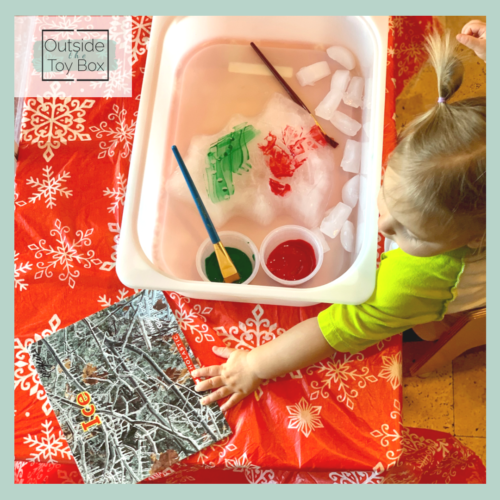
Squeeze bottles, pipettes, eye droppers, or turkey basters
Want a great fine motor workout? Get some materials for squeezing.
Check out our favorite sensory play tools
Teethers in water for babies
Have a teething baby or a child that constantly puts things in their mouth? Try adding different teethers to water. They can grab them and mouth them without any worry.
This is the ultimate low-prep, low-motivation water play activity.
Check out my 7 Hacks for Teething Babies and Exhausted Parents if you are looking for unique solutions for your little teething babe.
Frozen Fruit or Flowers
To make, get some pieces of either fruit or flowers and put them in an ice tray. Fill with water and freeze overnight. Add them to water and your child will have fun trying to get them out or watching until they melt to reveal the surprise.
Water Experiments
You can ask some questions to inspire curiosity and critical thinking. Check out this fabulous post “Science by the Pool: Easy Summer STEM Activities” from team-cartwright.com for some STEM ideas using water to play and learn a little something too.
Empty Soap pump bottles
Children love to play with soap bottles, especially when they have a pump. When you have an empty soap container, save it and wash it out for water play. You can even add it to your doll or animal wash or to your potions.
Magnets
Add a magnet wand and some magnetic pieces to water and it adds a whole new interest to the magnets (and to the water). If you don’t have a magnet wand, you could use other magnets that you may have around the house (check your fridge). If you have magnet blocks, that would be really fun to build in water as well.
Ice block
See “Ice Block Toy Dig Outside Sensory Activity” to see how teachinglittles.com did the ice block with toys.
Water Guns
Have a water gun fight. If you don’t have water guns or are against any type of gun in your home, then you can also use spray bottles, sponges, or water sprayers. You can also set up targets so they aren’t spraying each other or you.
Color sorting
Add some various colored toys and matching colored bowls or cups. Have your child scoop the toys and sort them into categories. A fun thing to sort is colored reusable ice cubes.
I hope these ideas have helped you get started with some summer fun. Be sure to save it for your future reference.
Need some gear for your summer fun?


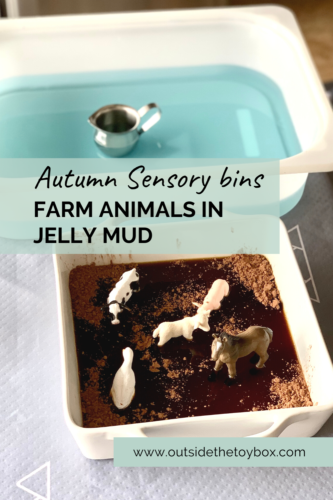
Trackbacks/Pingbacks